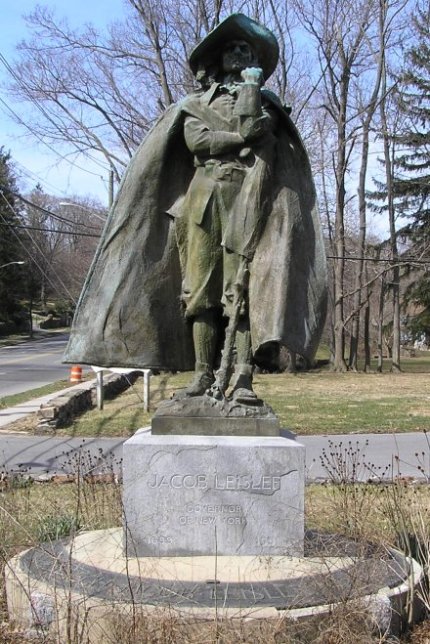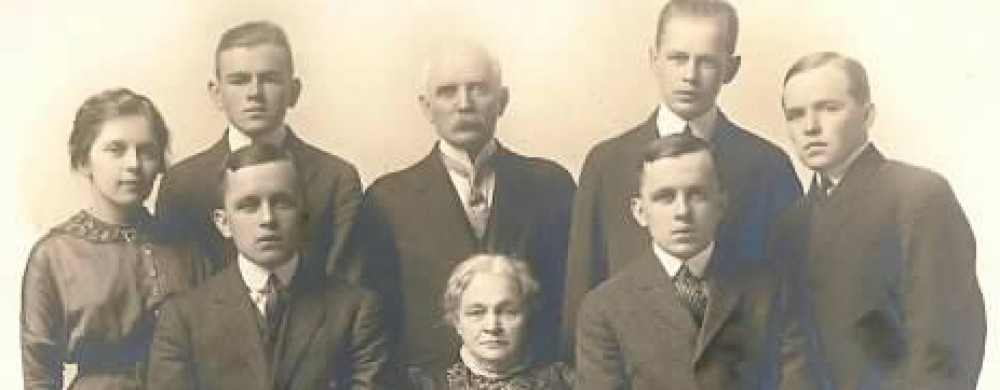With the current events focus on the US government charging whistleblowers, journalists and other leakers of embarrassing information with “aiding the enemy,” and threatening dire consequences, I thought it timely to mention my family tie to a man who was executed for treason.
I had a cousin in colonial New York named Elsje Tymens. She was a wealthy widow in 1663 when she married a German bachelor and son of a clergyman, Jacob Leisler. Over the next thirteen years, Jacob and Elsje built connections in business and government, accrued wealth, and added seven little Leislers to the household. Jacob was a merchant, captain of the militia, and appointed by the courts to administer estates and other property matters. A devout follower of John Calvin’s brand of religious reform, he identified with the (French Protestant) Huguenot community.

Statue of Jacob Leisler in New Rochelle, New York,
courtesy of Wikimedia Commons.
In 1685, England’s Charles II passed into history and his brother, James II (also James VII of Scotland and James II of Ireland), a Roman Catholic, succeeded him to the throne. To govern the Dominion of New England, James appointed Edmund Andros to sit in Boston, and Francis Nicholson, lieutenant governor, was assigned to administer the province of New York. Their authoritarian style of rule made both men intensely disliked by the colonists. Nicholson proclaimed the inhabitants of the former New Netherland (taken by England in 1664), “a conquered people” who could not “claim rights and privileges as Englishmen.”
Across the Atlantic, political factions were so alarmed by King James’s policy of religious tolerance and his ties to France, that they invited William III, the Dutch Prince of Orange, to invade with his fleet (and his English wife, Mary). James was deposed in a coup known as the Glorious Revolution.
When the news reached American shores, it sparked a popular uprising against Governor Andros in Massachusetts, and New York’s militia rebelled and forced Nicholson to yield Fort James, which controlled New York Harbor. The next day, a council of militia officers asked Jacob Leisler to take command. A few weeks later, a delegation from Lower New York and East Jersey chose Leisler as the province’s commander-in-chief, to act on behalf of England’s new monarchs, William and Mary, until a new governor was legitimately appointed.
Not all New Yorkers were pleased. In his rise to prominence, Jacob Leisler had made enemies that included his in-laws, the powerful Bayards and Van Cortlandts. Diplomacy was not his strong suit. An anti-Leisler faction coalesced in Albany, and grew dangerously.
In late 1690, William III commissioned Colonel Henry Sloughter as his new governor, but Sloughter’s ship was delayed and his lieutenant governor, Ingoldesby, arrived first. Ingoldesby demanded Leisler turn over the fort and governmental reins to him, but, because he lacked the proper papers, Leisler refused. Even when Sloughter made it to New York, Leisler remained suspicious, and took his sweet time before he surrendered and to his cost. Leisler’s reward for accepting the management and defense of New York in the name of King William III, – was his arrest on charges of treason.
Jacob Leisler, his right hand man and son-in-law, Jacob Milbourne, and eight other men were tortured, tried, convicted, and condemned to be “hanged, drawn and quartered, and their estates confiscated.[1]” The panel of judges was stacked with a significant number of anti-Leislerians.
Governor Sloughter seems to have had some misgivings about the result, as he wrote a letter to King William about the matter. However, in it, he trashed Leisler, did not include trial transcripts, and failed to mention the death sentence. Also, the court refused the request to send the condemned to England for an appeal.
It’s been written that Governor Sloughter was bribed, that he was drunk, – perhaps, he was both when, at the instigation of Leisler’s enemies, he signed the death warrants. Leisler’s only ‘luck’ is that he avoided being drawn and quartered, was “merely hanged til ‘halfe dead’ then beheaded[2]” as was his son-in-law, Jacob Milbourne, on May 16, 1691. None of the others convicted were executed.
Petitioners to London who included the younger Jacob Leisler, won a hearing before the king. Within a year of their execution, Leisler, Milbourne, and the remaining prisoners were pardoned. Parliament later passed a bill that would return the property stripped from Leisler’s heirs, and which was approved by the king in 1695. But it was 1698 before the family estate was restored, and the bodies of Leisler and Milbourne were moved from the dirt beneath the gallows and laid to rest in the yard of the Dutch Reform Church.
Scholars today recognize Leisler’s Rebellion as a precursor to the American Revolution. It was a power struggle of middling folks against an entrenched elite, – not treason. That’s something to think about as we Americans celebrate the 237 anniversary of our national ‘treason,’ – independence from England.
Wishing all my readers a wonderful Fourth of July!
[1] McCormick, Charles H (1989). Leisler’s Rebellion. Outstanding Studies in Early American History. New York: Garland. ISBN 0-8240-6190-X.p.357.
[2] Voorhees, David William, Remembering Jacob Leisler, The New York Genealogical and Biographical Newsletter, (New York: The New York Genealogical and Biographical Society, Spring/Summer 2002), p. 29.
